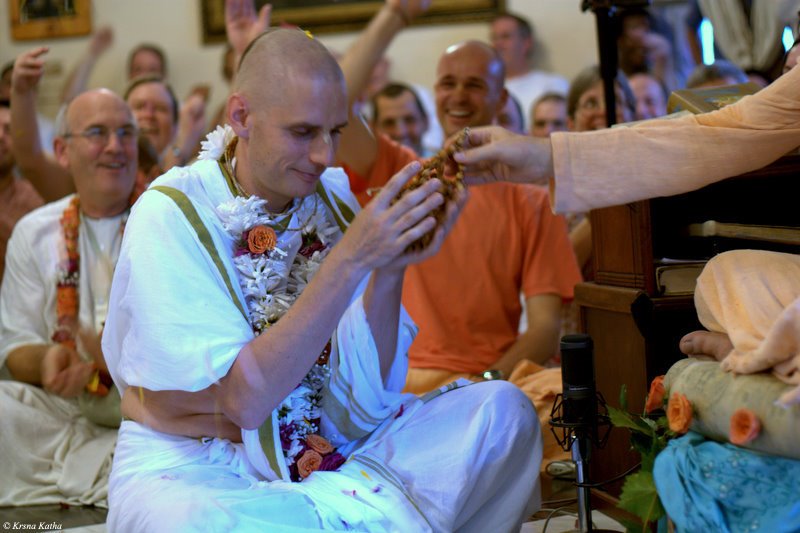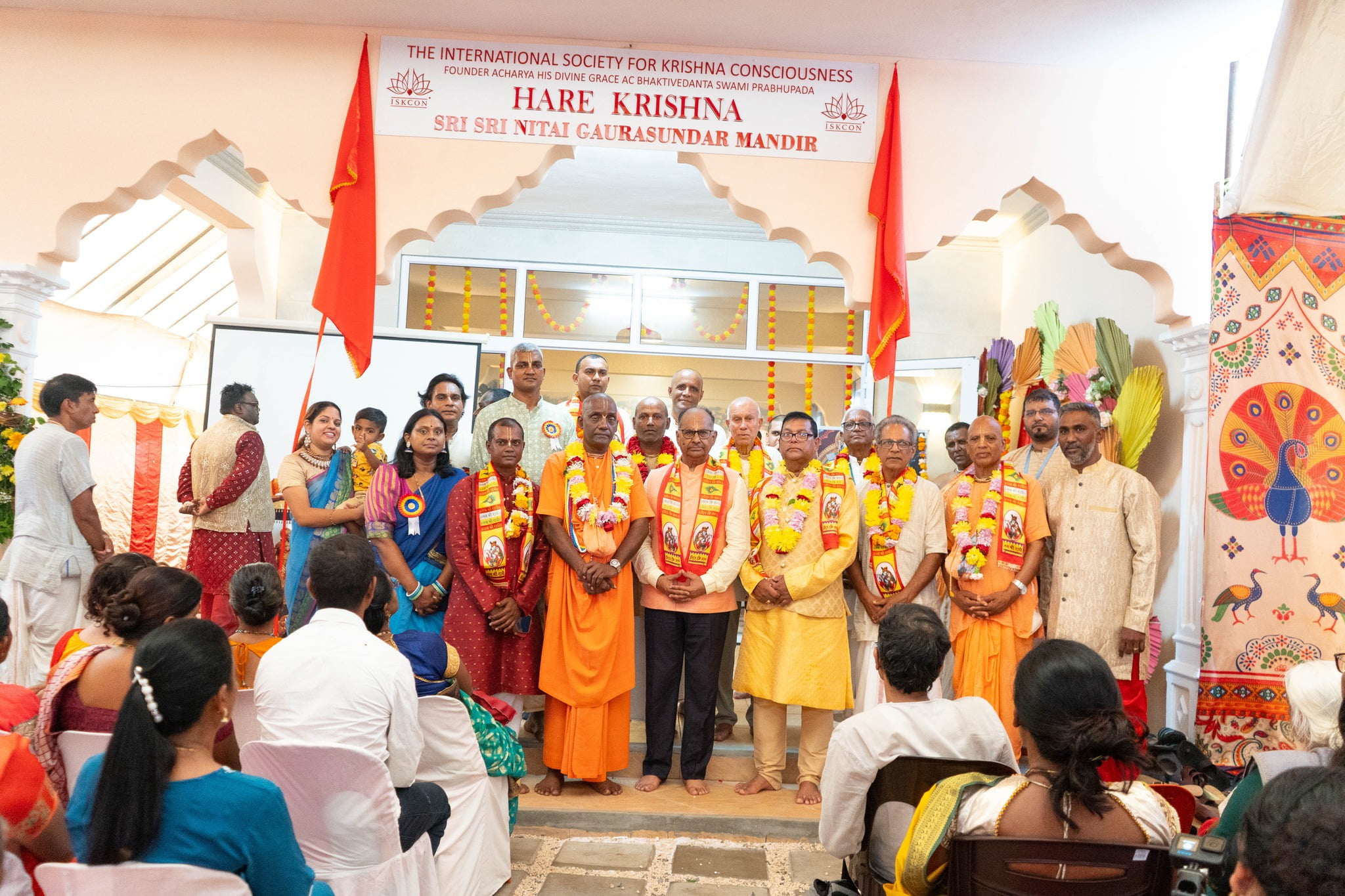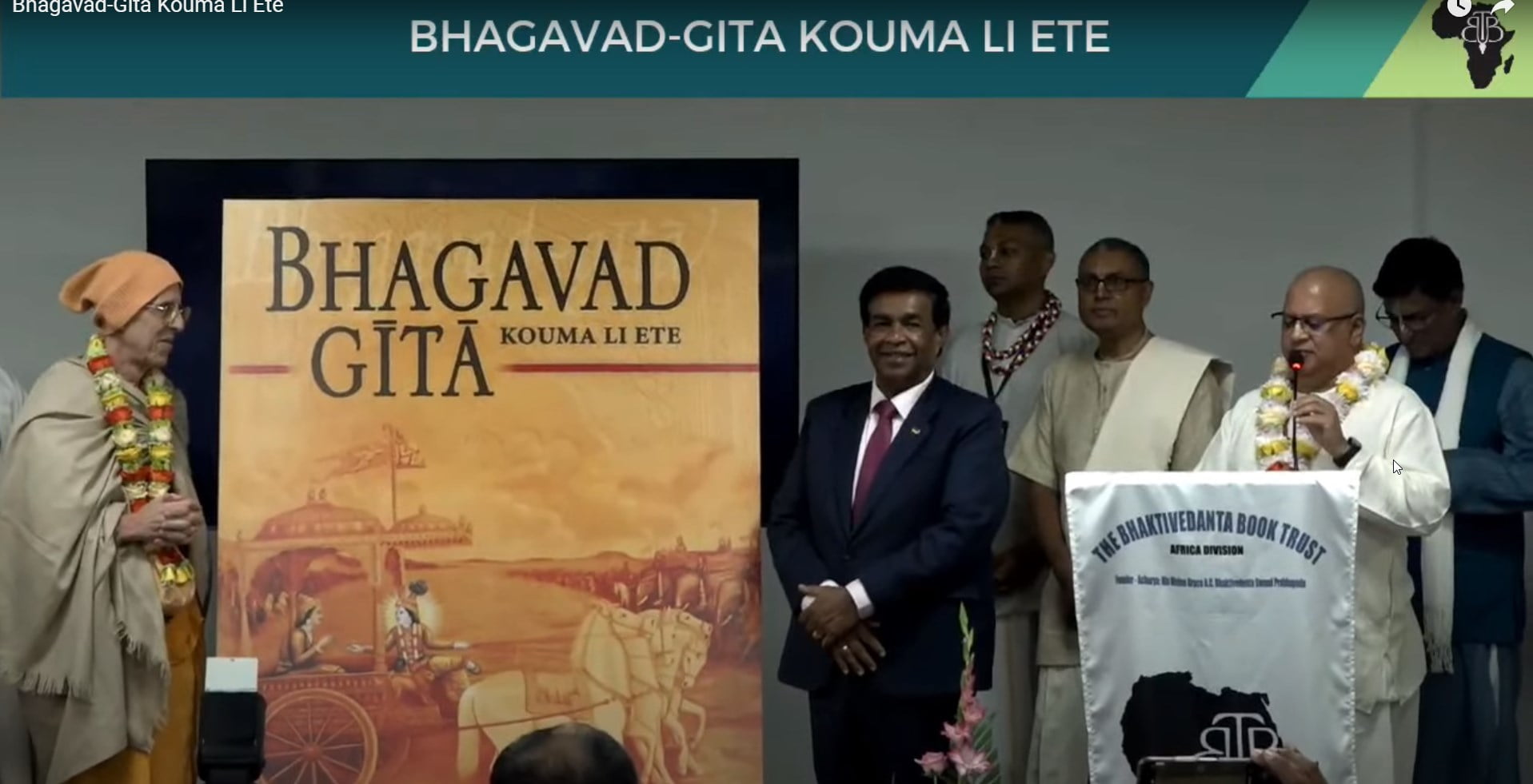As More Take Initiation, Second Generation Looks Deeper
By Madhava Smullen | Oct 09, 2011

When ISKCON Youth Ministry’s Manu and Jaya Radhe were initiated into the Gaudiya Vaishnava line on September 25th in their hometown of Alachua, Florida, it was a significant day for all.
Significant for the two initiates, who, in becoming disciples of ISKCON guru Sacinandana Swami and receiving their new names Manorama Dasa and Jaya Sri Radhe Dasi, were taking the next step in their spiritual life after years of dedicated service. Significant for their family, friends, and the many second generation devotees whose lives they had touched, who felt joy and whose own questions and doubts about initiation may have been answered by Sacinandana Swami’s deeply clarifying talk. And significant for the society of ISKCON, as a day symbolistic of the recent upsurge in “gurukulis” taking initiation.
In Manorama and Jaya Radhe’s hometown of Alachua, Florida alone, recent initiates in the past three years have included gurukulis in their mid-twenties like Dattatreya Yogesvara Dasa, Balarama Tirtha Dasa, Lalita Shyam Dasi, Bhakti-lata Dasi, and Jagannath Kirtan Dasa. Then there’s teenager Ramachandra Kaviraja Dasa, who received his second, brahmana initiation in Mayapur recently.
Meanwhile in New York, there’s kirtan singer Achyuta Gopi Dasi, and in Toronto youth leaders and Rathayatra organizers Keshava Dasa and Mahasundari Madhavi Dasi. The future is also lined with second generation devotees taking this serious step, with Mantralogy Records’ Rasacharya Dasa set to take initiation from Radhanath Swami soon in Washington D.C. And there are many more.
Does this mean that ISKCON’s second generation, after historically being more hesitant about taking the step of initiation than their parents, are now taking up the torch? Does it answer the question that currently concerns many of our senior members and leaders of who will succeed them and manage ISKCON when they are gone?
Manorama Dasa’s responses to these questions are thoughtful and multi-layered, with no easy answer.
“Certainly the more you get serious about your own Krishna consciousness, the more you feel inspired to carry on the important preaching work of our movement,” he says. “And of course according to the standards that Srila Prabhupada set, you must be chanting sixteen rounds and following the four regulative principles to take on meaningful practical service and positions of responsibility in ISKCON, such as being a temple president or going on the altar and dressing the Deities. So taking initiation is like saying okay, I’m now an official, committed, card-carrying member, please give me some responsibility.”
However, Manorama—who took initiation at the age of 39 after being a devotee for 33 years and seriously practicing Krishna consciousness for much of that time—says that initiation is a very deep personal decision and should be taken when one is ready and not for any external reason.

Jaya Sri Radhe blisfully accepts her initiation beads
“All my life, I’ve had a lot of pressure from well-wishing spiritual aunts and uncles to get initiated,” he explains. “And now, because myself and Jaya Sri Radhe have worked with the youth a lot, people are patting us on the back and saying, ‘What a great example! Now all the other gurukulis will get serious and get initiated too!’”
But Manorama, who became the GBC Youth Minister in 1996, wants to be crystal clear that he doesn’t want anyone else to feel the pressure that he did, and that setting an example for others was not his reason for getting initiated.
“If anything, the message I want to send to others is take your time, and don’t do it because everybody else is doing it or because others want you to,” he says.
“This is a very serious commitment, not to be taken lightly. Instead, really look deep within your heart and seriously consider the nature of the commitment, and the surrender, and the spiritual benefits of taking initiation. And see if it’s something that you want to do. Remember, Srila Prabhupada got initiated when he was thirty-six years old, and Bhaktivinode Thakura when he was in his forties. So there’s no rush.”
There are many reasons why gurukulis have been hesitant or slower about taking initiation. Some were abused and mistreated in ISKCON schools in the early days, and have an understandable mistrust of the society. Others are apprehensive because so many ISKCON gurus have left the society, and prefer to just take shelter of Srila Prabhupada.
“It’s easy to understand that perspective,” Manorama says. “I aspired to three different gurus who left before meeting Sacinandana Swami and feeling that everything was just right. But for me, there’s nothing like the student, the son of Srila Prabhupada being physically there in front of you to answer questions and clarify doubts. Also, with maturity, we can understand that it’s the guru principle that we’re surrendering to, the authorized path that the guru represents.”
Another reason why gurukulis have taken time to get initiated is that, like Manorama, they don’t want to take it cheaply.

Dattatreya Yogesvara about to take initiation from Jayapataka Swami in March 2011
“Throughout my life, I saw many new people joining ISKCON, getting initiated after six months so that they could have a spiritual name and be accepted in the community, and then leaving two years later,” he says. “My generation all saw that, and didn’t want to take initiation so lightly. We knew we weren’t ready yet, and I think that’s why many of us avoided it for so long.”
Of course, for many gurukulis—who already have spiritual names and are already accepted by the community—lethargy has also been a problem. Not getting initiated has sometimes been an excuse for not getting more serious about Krishna consciousness.
“As a generation, we’ve often been ‘fair weather’ devotees,” says Manorama. “We turn up when everything’s fine and dandy, at festival times or Sunday Feasts, maybe when there’s a kirtaniya in town we like. Personally, after a while I found that not getting initiated was becoming an excuse to not surrender, to never actually promise to chant sixteen rounds a day. I loved kirtan—we do as a generation—and I had no problem with the four regulative principles—but japa was hard for me. Some days would be good, some bad, and sometimes there’d be weeks or months of slacking and neglecting my rounds. There would always be something else that came up. Finally I thought, no more excuses.”
At the same time, Manorama began reading Srila Prabhupada’s purports to the Bhagavad-gita and Chaitanya Charitamrita more, and was struck by how many times taking shelter from a guru was mentioned as a foundational principle, and as the proper medium through which to surrender to Krishna.
A few years later, he began attending japa retreats led by Sacinandana Swami to work on his chanting, and reconnected with him for the first time since the guru had visited his house and introduced him and his parents to Krishna consciousness in Germany when he was just six years old.

Bhakti-lata receives initiation from Radhanath Swami in 2010
“It just felt right,” he says. “It felt like I had come full circle. And it was important to me that here was a person who was really into chanting good japa and teaching others about it.”
Now that he is initiated, Manorama feels like he has undergone a complete spiritual renewal.
“It’s a deep commitment,” he says. “I’m no longer serving Krishna whimsically, I’m actually committing and taking responsibility. My relationship with Krishna has to become my number one priority. Now I don’t just chant when I feel like it—the first thing I do every morning when I wake up is prioritize my day so that I can fulfill my initiation vows. And in doing so, my respect has grown tremendously for all of the other devotees in the world who are able to do that every day.”
For Manorama, initiation means going deeper into Krishna consciousness, and trying to rearrange his life in a way that prioritizes Krishna’s pleasure, rather than his own.
“For thirty-three years, my Krishna conscious life has been an outward journey,” he says. “I’ve tried to please Krishna by organizing big preaching projects like annual bus tours for the youth. Now it’s time to really look inward, focus on chanting the Holy Name, and become clean inside.”
It certainly looks like rather than following any “get initiated trend,” gurukulis are beginning to look deeper within themselves and take the next level of commitment to Krishna consciousness very seriously. And whether or not they begin to take on more management roles or practical responsibilities in ISKCON, that can only mean very bright things for the future of Srila Prabhupada’s Society.












